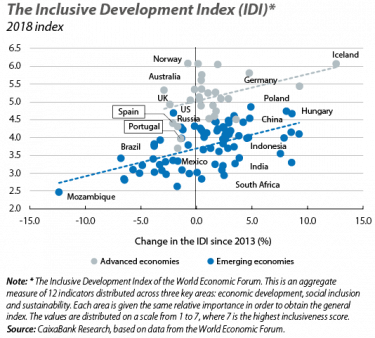Inclusive growth: the forces of the future
According to the OECD, an economy’s growth is inclusive when it is distributed equitably among society and creates opportunities for all. This is a complex concept and requires a detailed analysis in order to determine how inclusive growth has evolved over time, but the growing income inequality in most advanced economies already indicates that the trend is not exactly favourable.
In order to better assess the extent to which a country’s economic growth is inclusive, the World Economic Forum has developed an index that takes into account other variables besides income inequality that are indicative of the level of inclusion, such as life expectancy, poverty rates and the dependency ratio. Although there are notable differences between countries, the final message is not very encouraging: following the deterioration in the index during the financial crisis, it has barely recovered in recent years. In fact, the persistent deterioration in the inclusive growth indices in many countries fuels fears that we have entered a phase of secular exclusion (see the chart).
In this situation, it is not surprising that inclusive growth is one of the priorities in the agendas of most international institutions. In recent decades, several factors have arisen as possible causes of the deterioration in the inclusiveness of growth, but the most prominent candidates are technological change and globalisation. Specifically, while these factors should be capable of improving the well-being of the population as a whole, their benefits and costs do not appear to have been distributed fairly or equitably among different individuals. Another factor to add to the list is the slow adaptation of regulation to the new economic context, which implies that there are significant asymmetries in the degree of regulatory control in particular sectors or economic areas.
Technological change: from computers to AI and machine learning
The appearance of computers and the first wave of robotic automation of manufacturing plants greatly favoured economic growth, but not in a very inclusive manner. In particular, in many advanced countries (such as the US and the United Kingdom), the wage gap between workers with higher levels of education («skilled» workers, according to the economic jargon) and those with a lower level of educational («unskilled» workers) increased significantly.1 Furthermore, workers with a more basic education endured higher unemployment rates. The robotic automation of manufacturing plants had a negative impact on the demand for workers with a relatively low level of educational, as well as on their wages, since the new robotic machines served as good substitutes for the tasks they performed. In contrast, computers increased the productivity of workers with a higher level of education, which also had a (positive) impact on their wages. In summary, these technological changes clearly favoured skilled jobs, while being detrimental, therefore, to those on lower incomes (were skilled biased).
The technologies of the future (some of which are already of the present) will also effect workers, although on this occasion it seems that the impact is going to be less linked to people’s level of educational. For instance, artificial intelligence (AI) has the potential to affect workers with a wide range of skill levels: from telephone operators or people who provide support and help to the elderly (through the development of chatbots, for example), to taxi drivers, translators and doctors (such as radiologists). We do not have to look very far to see that we already have the first driverless cars and programs that analyse medical images, and there is no doubt that translation applications are getting better all the time.
In this regard, some of the results reached by the director of MIT’s Initiative on the Digital Economy, Erik Brynjolfsson, together with other co-authors, suggest that the phenomenon of machine learning will not directly lead to an increase in polarisation. This is because there is no clear relationship between occupations that could be more easily replaced by machine learning techniques and the level of wages that these jobs currently have.2 Nevertheless, this and other technologies that are being developed could end up causing the destruction of many jobs although they can also generate new ones. Therefore, a labour framework that protects workers who lose their jobs and helps them to successfully rejoin the labour market will be key (see the article «Employment policies for inclusive growth» in this Dossier), as will be education policies that prepare future workers for the changes to come (see the article «Education as a lever for inclusive growth» in this same Dossier).
The view from the emerging countries is somewhat different, since in this case information and communication technologies appear to have a high potential to improve the level of inclusion. This is because these technologies considerably help workers in the primary sector, who are on lower incomes, to gain better access to the markets where they sell their products, thus substantially increasing their income.3
Offshoring: from manufacturing to services and back again
Over the past few decades, one of the most visible faces of globalisation has been the rise of offshoring (either via companies moving their operations abroad or through outsourcing), particularly in the manufacturing sector. Much like the technological change was biased in favour of skilled labour, the offshoring of manufacturing jobs has fuelled economic growth but has also made it less inclusive. In particular, in advanced countries, many companies have fragmented their production process and transferred part of it to other economies, mostly emerging ones, in order to take advantage of lower costs (specifically, labour costs). This has had an especially adverse effect on less skilled workers in developed countries (in the form of lower wages and higher unemployment rates).4
Nevertheless, in the future, offshoring could have different implications for the inclusiveness of economic growth. According to a recent study by Branstetter, Glenon and Jensen, US companies have considerably increased the level of offshoring of R&D to emerging countries such as India and China. The reason for this is the increasing role of information technologies and software in developing business innovation, together with the increase in the number of specialists in these two fields that exist in emerging countries.5 These dynamics suggest that the offshoring of services will affect skilled workers to a much greater extent than the offshoring of manufacturing.
On the other hand, the sharp decline in the price of industrial robots6 could lead to a certain degree of reshoring of some of the manufacturing processes that companies had previously moved to emerging countries (i.e. reintroducing domestic manufacturing). This, without a doubt, will have positive effects on the labour market in advanced countries, since robots require maintenance and repairs, among other complementary tasks.
In short, although the future is uncertain, what is clear is that artificial intelligence, machine learning, the co-existence of the offshoring of manufacturing with that of services and, possibly, reshoring will influence the inclusiveness of economic growth in a very different way to in the past. And we must be ready.
Clàudia Canals
CaixaBank Research
1. See Feenstra, R. C. , and Gordon, H. (1999), «The Impact of Outsourcing and High-Technology Capital on Wages: Estimates for the United States, 1979-1990», The Quarterly Journal of Economics 114.3: 907-940. Also see Canals, C. (2006), «What Explains the Widening Wage Gap? Outsourcing vs. Technology», CaixaBank Research, Working Papers.
2. See Brynjolfsson, E., Mitchell, T. and Rock, D. (2018), «What Can Machines Learn, and What Does It Mean for Occupations and the Economy?» AEA Papers and Proceedings, vol. 108.
3. The example of the use of mobile phones by fishermen in India’s Kerala region is one of the most obvious cases. See Jensen, R. (2007), «The Digital Provide: Information (Technology), Market Performance, and Welfare in the South Indian Fisheries Sector», The Quarterly Journal of Economics 122.3: 879-924.
4. See the references of note 1.
5. See Branstetter, L. G., Britta, M. G. and Jensen, J. B. (2018), «The IT Revolution and the Globalization of R&D», n° w24707, National Bureau of Economic Research.
6. According to data from ARK Invest, the cost of industrial robots has fallen from 131,000 dollars in the mid-1990s to 31,000 dollars today.




